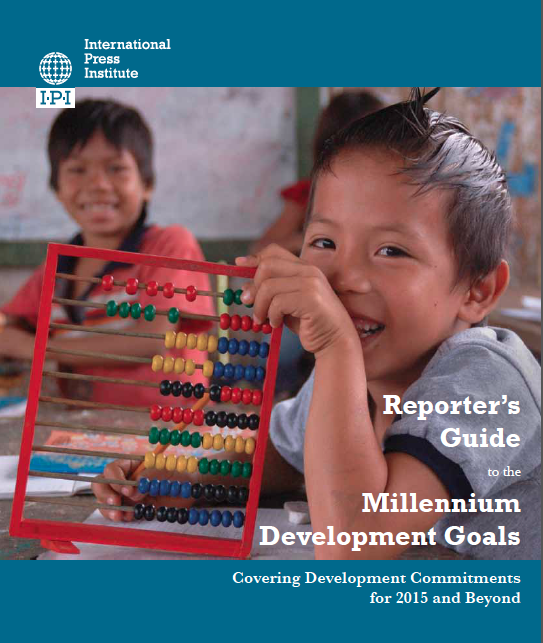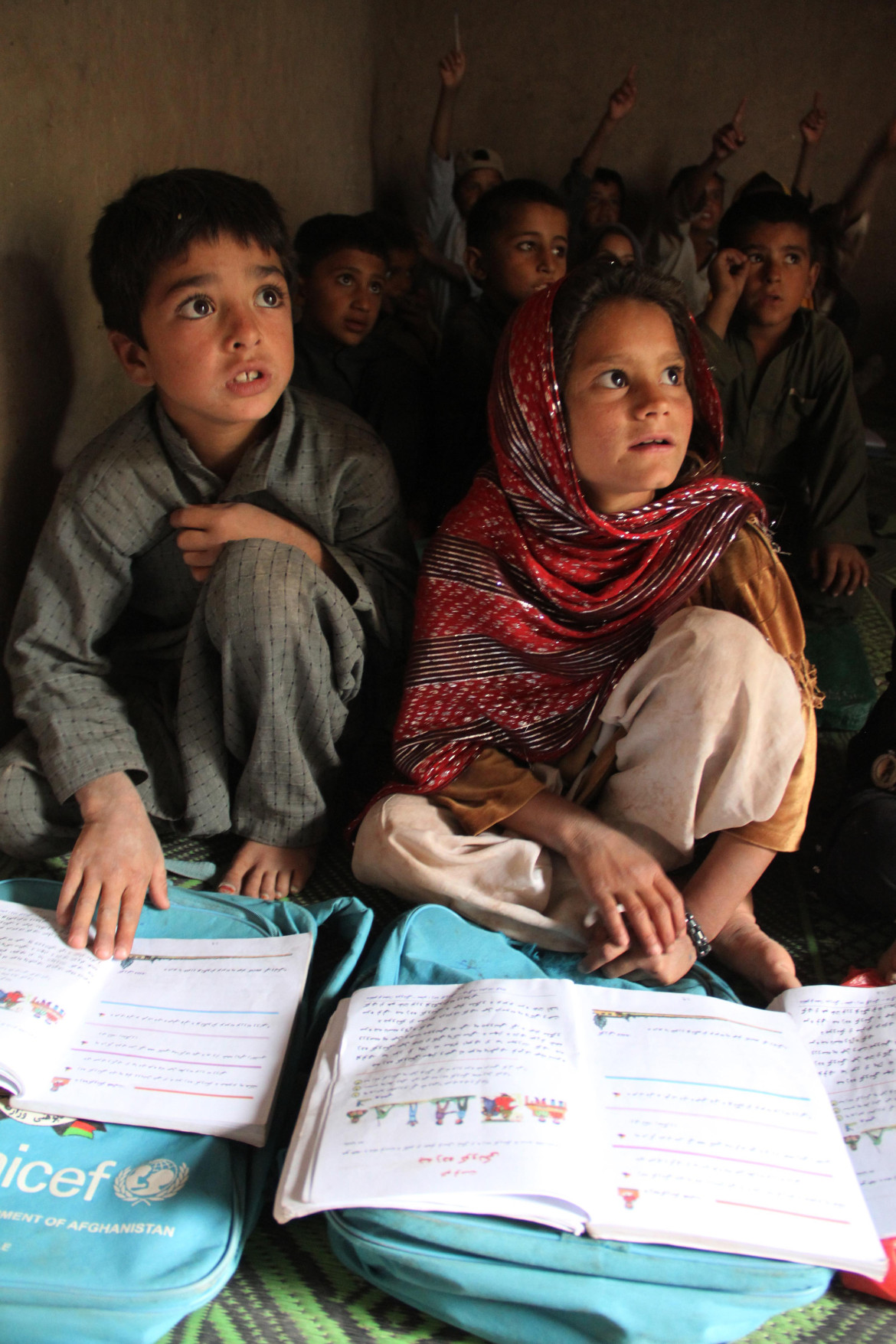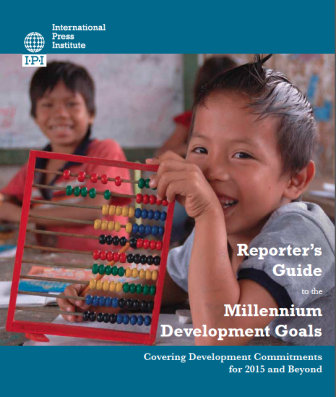

Reporter’s Guide: A Millennium Development Goal Primer
 Part 2 of a series GIJN is excerpting from the Reporter’s Guide to the Millennium Development Goals: Covering Development Commitments for 2015 and Beyond, published by the International Press Institute.
Part 2 of a series GIJN is excerpting from the Reporter’s Guide to the Millennium Development Goals: Covering Development Commitments for 2015 and Beyond, published by the International Press Institute.

Afghanistan. Reports indicate that about 4.5 million Afghan children of school age remain deprived of education, and illiteracy remains widespread. EPA/S. Sabawoon
To Hermilio, a working day is no less than 12 hours. In return, he receives a wage that does not guarantee that his two children, who are six and seven years old, have food three times a day, nor does it prevent them having to walk miles to reach the nearest school.
This is the reality in the Cusarare community in Chihuahua, northern Mexico, and in many other parts of the world. The Millennium Development Goals (MDGs)—which underpin an alliance between governments and society geared at eradicating marginalization—were created up in response to the suffering of Hermilio and the billions of others like him around the world.
Drawn up in 2000, the United Nations Millennium Declaration, which contained the MDGs, was originally signed by 189 heads of state and now encompasses all 193 UN member countries. Significantly, signatory nations with greater purchasing power pledged more development assistance to all peoples, through external debt cancellation and the establishment of fairer trade rules, allowing for more equitable economic growth among nations.
In 2010, at the UN Summit on the Millennium Development Goals, the process of MDG achievement was analyzed. With an eye toward 2015, countries were urged to develop action plans and high-impact solutions for areas where the statistics still fell (far) short of the ideal.
The commitment to achieve the Goals by 2015 is a matter not just for those in power, or for underdeveloped governments, but for society as a whole: NGOs, corporations, educational institutions, and the media should cooperate in a bid to meet the MDG deadline.
Overview of the MDGs
The first goal is to eradicate extreme poverty and hunger. According to the most recent UN MDG Report (2012), poverty is on the decline in all regions of the world, and the percentage of individuals living on less than US$1.25 a day has been halved since 1990. But overall progress has been slowed by the global financial crisis that began in 2007, and current projections estimate that 1 billion people (16% of the world’s population) will still be living in extreme poverty in 2015.
To respond to the continued challenge of hunger, many governments and organizations have set up food banks and have increased the availability of staple crops to ensure food independence. In some places, in Latin America for example, community cooperatives have been created in order to deal with food shortages during extreme weather conditions, such as drought.
To achieve universal primary education is the second goal. Figures in 2010 indicated that 90 percent of primary-age children now attend school, but, here as well, progress is slow. The 2012 UN Report indicated that improvements have dropped considerably since 2004.
While companies and foundations have started building schools, granting scholarships, and offering more incentives to teachers to work in rural areas, improvement in the quality of instruction is still needed. Governments, meanwhile, have made efforts to increase enrollment at the basic level. Here, it is important to note that assessments of MDG Goal Two by local and international NGOs are more rigorous than governmental ones, as the former measure not only how many children go to school, but also what and how they are taught, and whether knowledge is retained.
The third goal is to promote gender equality and empower women. To this end, the UN Development Programme (UNDP) and the UN Entity for Gender Equality and the Empowerment of Women (UN Women) provide advice and support to projects designed to increase gender equity. In several countries, civil-society organisations have been trained to promote legislation to ensure gender equality, and to build community centers for women. As with all the MDGs, civil society and the media are critical to the success of furthering gender equality because they champion and evaluate specific policies, and also report unacceptable delays in achievement. For example, there are laws that, in certain cases, exonerate the killers of women if the perpetrator is perceived to have acted “in defense of honor.” Journalists can expose such cases while NGOs can lobby legislators to modify the relevant legal statutes.
The fourth goal is to reduce child mortality, specifically, cutting the rate of under-five deaths by two-thirds. Urgent measures are still needed here. While several regions, including northern Africa and eastern Asia have seen improvements of more than 50%, sub-Saharan Africa, for example, has seen a reduction of just 30%, according to the most recent UN figures. In addition, statistics indicate that despite general gains in under-five mortality, 23 out of every 1,000 children worldwide still do not survive their first month.
Meeting this target requires global involvement. Anyone and everyone can play a role: even football clubs have joined together to create humanitarian aid programs both to deliver food to the world’s poorest households—children born into poverty are far more likely to die early—and to promote sustainable living.
Measurement of the fifth goal, to reduce maternal mortality by three-quarters, is difficult, but international agencies such as the World Health Organization (WHO), UNICEF, the UN Population Fund (UNFPA), and the World Bank estimate that 290 maternal deaths occur per 100,000 live births worldwide. In an attempt to reduce this figure, health agencies are working together to encourage expectant mothers to have at least three check-ups during pregnancy. In addition, governments and health-care manufacturers have led joint initiatives to improve maternal health during pregnancy by distributing vitamins and folic acid.
The sixth goal is to combat HIV, malaria, and other diseases. Although HIV/AIDS infections have declined in sub-Saharan Africa, the changes are minimal in East Asia, Central Asia, and the Caribbean, and in all regions the highest rates of infection are among young people. As a result, governments, civil-society organisations, and entrepreneurs have implemented information campaigns, as well as prevention and detection programs, including free testing, so that new cases are detected and treated early.
The seventh goal is to ensure environmental sustainability. Although deforestation levels continue to be alarming, the number of protected areas is increasing. Meanwhile, to improve environmental sustainability in high-population, low-income areas, the UN has asked countries to conduct censuses among populations living in slums, and to establish realistic goals at the national, regional, and local levels to improve the lives of slum-dwellers. Priority is being given to housing and basic services, such as water and sanitation infrastructure, transport and energy, and health and education, in a bid to halve the number of people without sustainable access to safe water and sanitation. Governments and businesses are promoting green-home building, the redesign of urban areas, and the promotion of better local jobs to avoid internal migration. The fewer opportunities people have in their community of birth, the greater the potential increase in urban poverty.
Educational institutions have also participated in the design of risk atlases, which chart a variety of risks in local communities and, thereby, encourage relocation in the face of potential natural disasters, and the avoidance of construction in areas where the environment is threatened.
The reduction of debt and the promotion of humanitarian aid are central to the eighth goal, which is to develop a global partnership for development. Strong economies are essential to accomplishing this goal but because recent recessions have placed government finances under strain, private initiatives and resource management have become all the more critical.
Achievement of the MDGs requires constant evaluation. Their achievement depends on cooperation and interaction among governments, businesses, civil society and, of course, the media. It is essential to publicize both progress and delays, because when citizens are informed they can exert more powerful demands on government to live up to their development commitments.
 Ernestina Álvarez Guillén is a Mexican reporter who now works at the radio station MVS News. For years, she covered news on the issues of social development and health, but now covers politics. She was selected to attend the Balboa Program for Iberoamerican Journalists, which allowed her to work at the newspaper La Razón of Madrid, Spain.
Ernestina Álvarez Guillén is a Mexican reporter who now works at the radio station MVS News. For years, she covered news on the issues of social development and health, but now covers politics. She was selected to attend the Balboa Program for Iberoamerican Journalists, which allowed her to work at the newspaper La Razón of Madrid, Spain.
 Excerpted from Reporter’s Guide to the Millennium Development Goals: Covering Development Commitments for 2015 and Beyond. Agreed to in 2000, the UN Millennium Goals comprise an ambitious agenda to improve quality of life around the world, focusing on such issues as poverty, gender equality, and education. This unique manual, available in four languages, offers journalists practical tips on covering these critical areas as we near the 15th anniversary of the goals. Twenty-one journalists across six continents contributed to the report, including several active in GIJN. We are grateful to the publisher, the International Press Institute, for permission to publish the series, and to the European Press Photo Agency and EFE Agency for permission to publish the accompanying photos.
Excerpted from Reporter’s Guide to the Millennium Development Goals: Covering Development Commitments for 2015 and Beyond. Agreed to in 2000, the UN Millennium Goals comprise an ambitious agenda to improve quality of life around the world, focusing on such issues as poverty, gender equality, and education. This unique manual, available in four languages, offers journalists practical tips on covering these critical areas as we near the 15th anniversary of the goals. Twenty-one journalists across six continents contributed to the report, including several active in GIJN. We are grateful to the publisher, the International Press Institute, for permission to publish the series, and to the European Press Photo Agency and EFE Agency for permission to publish the accompanying photos.








